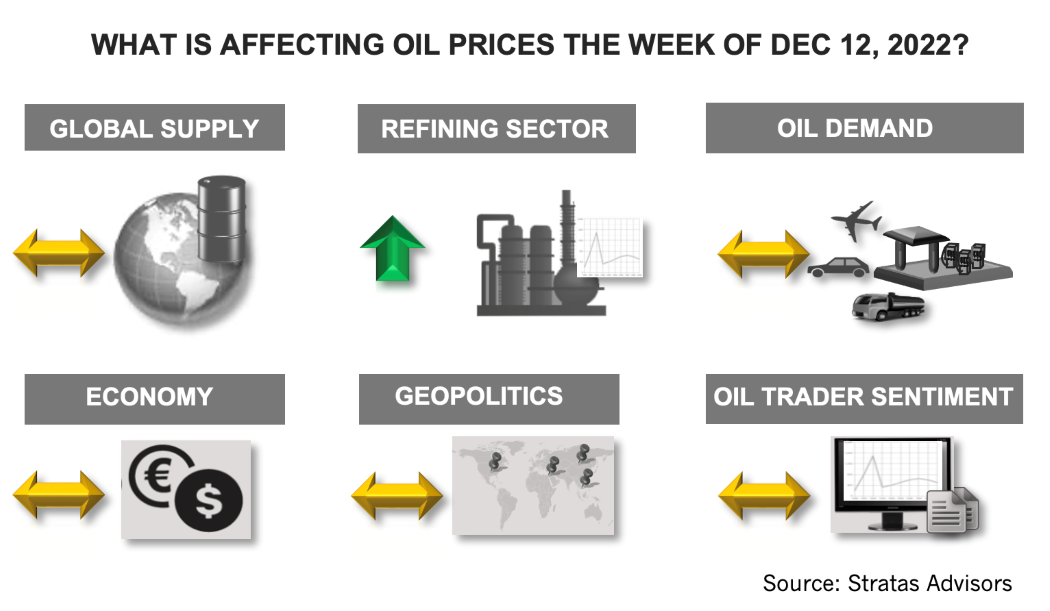
Brent crude and WTI prices both fell during the week ended Dec. 12. (Source: Shutterstock.com)
Learn more about Hart Energy Conferences
Get our latest conference schedules, updates and insights straight to your inbox.
The price of Brent crude ended the week at $76.10 after closing the previous week at $85.57. The price of WTI ended the week at $71.02 after closing the previous week $79.98. After last week decrease in prices, the price of Brent crude has dropped out of the channel between $85.00 and $95.00, which is the channel that we have been expecting oil prices to remain during 4Q of this year because of upside resistance coupled with downside support.
Last week, the price cap of $60.00 on Russian oil was imposed and the first signs of disruption occurred with a traffic jam involving around 38 tankers held up at the Bosporus Strait (29 tankers) and at the Dardanelles Strait (nine tankers). The traffic jam is the result of Turkey requiring additional proof of insurance, which western insurers are reluctant to provide because of concerns that doing so would expose the insurers to sanctions if the tankers were shipping oil sold at prices above the price cap. Turkey is insisting on the additional documentation because of concerns that damage resulting from an accident involving a tanker may not be covered by the international oil-spill fund. Interestingly, most of the tankers being held up are EU tankers headed for EU ports.
Additionally, OPEC members reduced supply in November by around 700,000 bbl/d in comparison to October with Saudi Arabia accounting for around 500,000 bbl/d of the reduction with its production decreasing to around 10.50 MMbbl/d. As has been the case for many months, African producers continue to produce well below their quotas with Nigeria and Angola underproducing by a total of 900,000 bbl/d. Together, members of OPEC+ are producing around 38.30 MMbbl/d, which compares to a November quota of 40.10 MMbbl/d and production of 38.60 MMbbl/d in October.

The supply issues, however, are being eclipsed by concerns about the global economy and the demand for crude oil. Oil demand in the U.S. continues to be weak, with demand for gasoline, diesel and jet fuel running below that of last year and well below pre-COVID levels. Oil demand associated with China and Europe also remains weak. There are signs, however, that the demand situation will be stabilizing. The latest data from the U.S. Labor Department indicate that inflation in the U.S. is increasing at a slower rate. Producer prices increased at the lowest rate since April 2021 with prices increasing by 0.3% in November. On a year-on-year basis, producers prices increased by 7.4%, which compares to 8.1% in October. China has taken some initial steps to shift away from its zero-COVID policies, including the elimination of the requirement of a negative text to utilize public transport with respect to several cities, including Beijing.
On the other hand, we still think that additional sanctions (including the price cap) on Russian oil exports will be of limited effectiveness, in part because China and India have not agreed to the price cap and continue to buy Russian crude oil, including the China’s independent refiners, which are important buyers of ESPO-grade crude oil. Additionally, we expect demand growth to remain muted with the U.S. economy facing challenges. The U.S. housing sector especially looks weak with existing house sales falling for nine consecutive months and house prices expected to decrease by 6% next year, according to a recent poll by Reuters. Another sign of weakness is the U.S. savings rate which was only 2.3% in October and the lowest rate in 17 years. During the height of the COVID pandemic, the U.S. savings rate was above 30% and pre-COVID the savings rate was above 8%. The decrease in the savings rate corresponds to the reopening of the economic activity, but also to real wages decreasing during the last 20 months. While China has started moving away from zero-COVID, the transition is not expected to be smooth with concerns about spikes in cases and possibly deaths. Also, China’s government officials are now facing the challenge of convincing the public and especially the elderly, that it is prudent to return to pre-COVID behavior.
So after all that, and considering everything from an integrated perspective, we are expecting that price of Brent crude will move back into the channel between $85.00 and $95.00.
For a complete forecast of refined products and prices, please refer to our Short-term Outlook.
About the Author: John E. Paise, president of Stratas Advisors, is responsible for managing the research and consulting business worldwide. Prior to joining Stratas Advisors, Paisie was a partner with PFC Energy, a strategic consultancy based in Washington, D.C., where he led a global practice focused on helping clients (including IOCs, NOC, independent oil companies and governments) to understand the future market environment and competitive landscape, set an appropriate strategic direction and implement strategic initiatives. He worked more than eight years with IBM Consulting (formerly PriceWaterhouseCoopers, PwC Consulting) as an associate partner in the strategic change practice focused on the energy sector while residing in Houston, Singapore, Beijing and London.
Recommended Reading
Chevron Hunts Upside for Oil Recovery, D&C Savings with Permian Pilots
2024-02-06 - New techniques and technologies being piloted by Chevron in the Permian Basin are improving drilling and completed cycle times. Executives at the California-based major hope to eventually improve overall resource recovery from its shale portfolio.
CEO: Continental Adds Midland Basin Acreage, Explores Woodford, Barnett
2024-04-11 - Continental Resources is adding leases in Midland and Ector counties, Texas, as the private E&P hunts for drilling locations to explore. Continental is also testing deeper Barnett and Woodford intervals across its Permian footprint, CEO Doug Lawler said in an exclusive interview.
E&P Highlights: April 15, 2024
2024-04-15 - Here’s a roundup of the latest E&P headlines, including an ultra-deepwater discovery and new contract awards.
For Sale, Again: Oily Northern Midland’s HighPeak Energy
2024-03-08 - The E&P is looking to hitch a ride on heated, renewed Permian Basin M&A.
Sinopec Brings West Sichuan Gas Field Onstream
2024-03-14 - The 100 Bcm sour gas onshore field, West Sichuan Gas Field, is expected to produce 2 Bcm per year.





